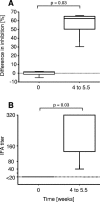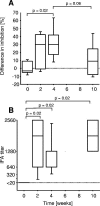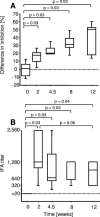Serologic cross-reactivity between Anaplasma marginale and Anaplasma phagocytophilum
- PMID: 16210480
- PMCID: PMC1247822
- DOI: 10.1128/CDLI.12.10.1177-1183.2005
Serologic cross-reactivity between Anaplasma marginale and Anaplasma phagocytophilum
Abstract
In the context of a serosurvey conducted on the Anaplasma marginale prevalence in Swiss cattle, we suspected that a serological cross-reactivity between A. marginale and A. phagocytophilum might exist. In the present study we demonstrate that cattle, sheep and horses experimentally infected with A. phagocytophilum not only develop antibodies to A. phagocytophilum (detected by immunofluorescent-antibody assay) but also to A. marginale (detected by a competitive enzyme-linked immunosorbent assay). Conversely, calves experimentally infected with A. marginale also developed antibodies to A. phagocytophilum using the same serological tests. The identity of 63% determined in silico within a 209-amino-acid sequence of major surface protein 5 of an isolate of A. marginale and one of A. phagocytophilum supported the observed immunological cross-reactivity. These observations have important consequences for the serotesting of both, A. marginale and A. phagocytophilum infection of several animal species. In view of these new findings, tests that have been considered specific for either infection must be interpreted carefully.
Figures






References
-
- Asanovich, K. M., J. S. Bakken, J. E. Madigan, M. Aguero-Rosenfeld, G. P. Wormser, and J. S. Dumler. 1997. Antigenic diversity of granulocytic Ehrlichia isolates from humans in Wisconsin and New York and a horse in California. J. Infect. Dis. 176:1029-1034. - PubMed
-
- de la Fuente, J., R. F. Massung, S. J. Wong, F. K. Chu, H. Lutz, M. Meli, F. D. von Loewenich, A. Grzeszczuk, A. Torina, S. Caracappa, A. J. Mangold, V. Naranjo, S. Stuen, and K. M. Kocan. 2005. Sequence analysis of the msp4 gene of Anaplasma phagocytophilum strains. J. Clin. Microbiol. 43:1309-1317. - PMC - PubMed
-
- Dreher, U. M., R. Hofmann-Lehmann, M. L. Meli, G. Regula, A. Y. Cagienard, K. D. Stark, M. Doherr, F. Filli, M. Hässig, U. Braun, K. M. Kocan, and H. Lutz. 2005. Seroprevalence of anaplasmosis among cattle in Switzerland in 1998 and 2003: no evidence of an emerging disease. Vet. Microbiol. 107:71-79. - PubMed
-
- Dumler, J. S., A. F. Barbet, C. P. Bekker, G. A. Dasch, G. H. Palmer, S. C. Ray, Y. Rikihisa, and F. R. Rurangirwa. 2001. Reorganization of genera in the families Rickettsiaceae and Anaplasmataceae in the order Rickettsiales: unification of some species of Ehrlichia with Anaplasma, Cowdria with Ehrlichia and Ehrlichia with Neorickettsia, descriptions of six new species combinations and designation of Ehrlichia equi and ‘HGE agent’ as subjective synonyms of Ehrlichia phagocytophila. Int. J. Syst. Evol. Microbiol. 51:2145-2165. - PubMed
Publication types
MeSH terms
Substances
LinkOut - more resources
Full Text Sources

